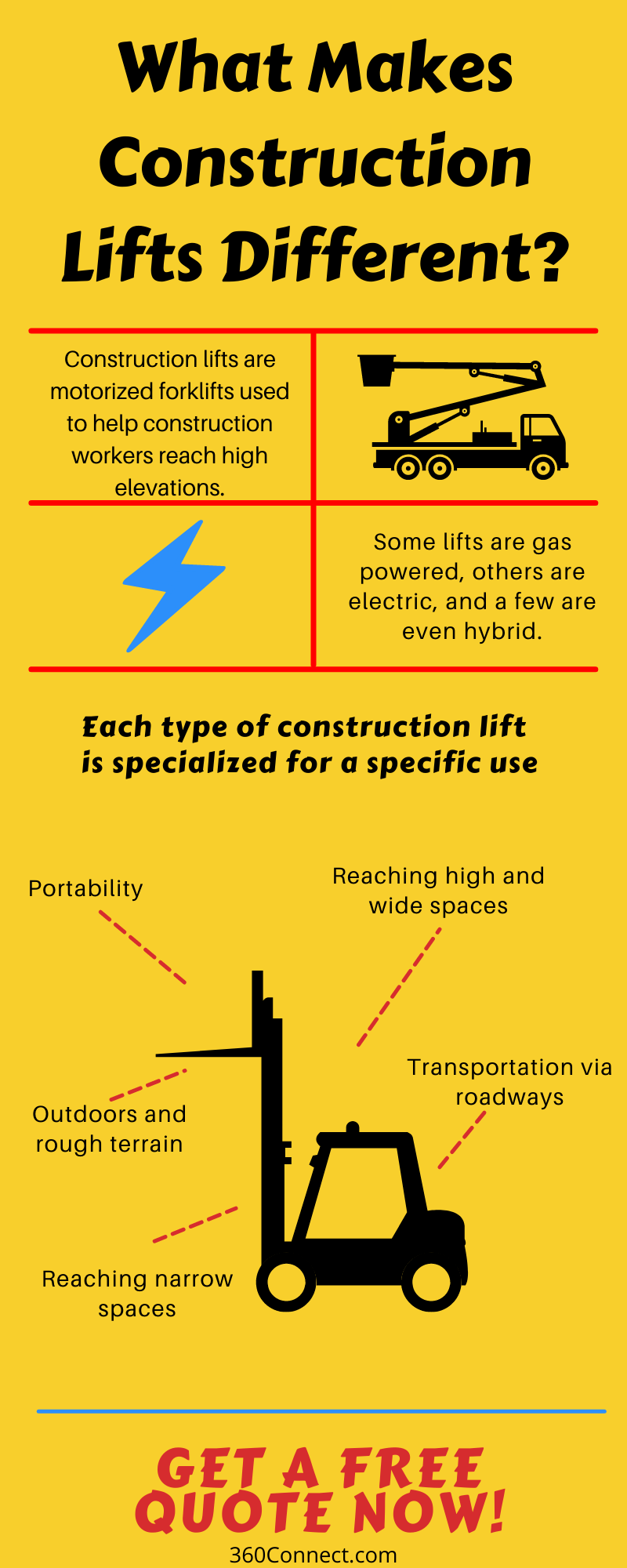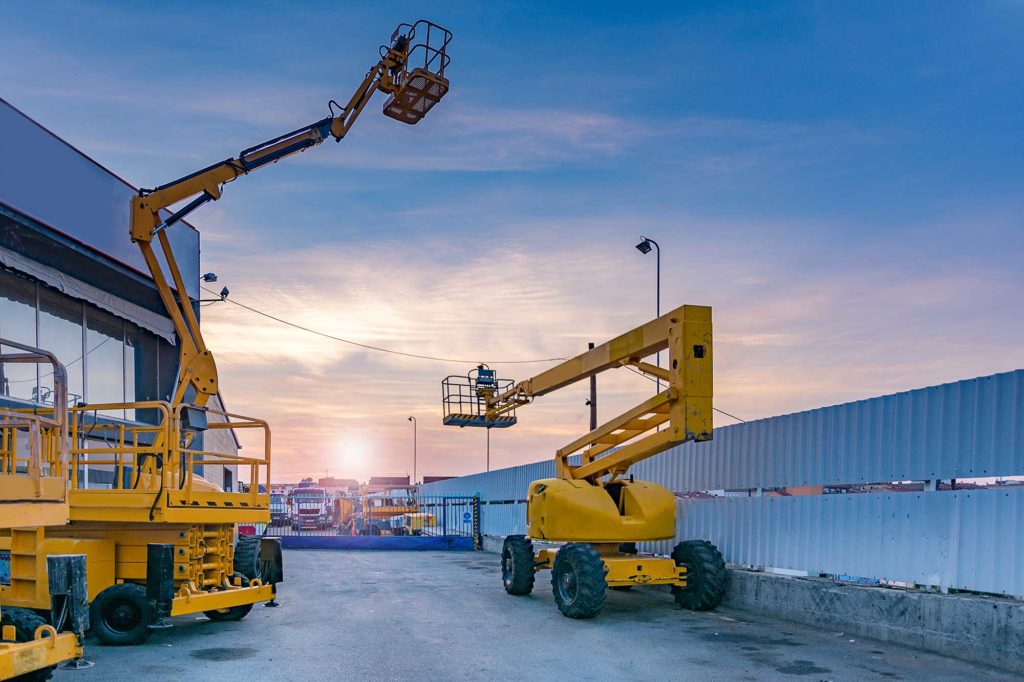You may already know that construction workers’ jobs are not easy! Construction is very labor intensive – workers constantly need to move heavy materials, as well as reach high elevations and hard-to-reach areas. That’s why construction lifts are a must-have on a daily basis at a majority of construction sites today. They help construction workers complete their job safely and effectively as well as boost productivity at job sites.

What is a Construction Lift?
A construction lift, also known as an aerial lift, aerial work platform (AWP), or man lift, is a motorized forklift used to help construction workers reach high elevations for jobs or projects. Construction lift equipment generally consists of a motorized vehicle with heavy duty tires and a work platform that can be raised and lowered as the worker needs.
There are several different types of aerial lifts that are designed for different construction jobs. The elevation the forklift can reach, the weight it can hold, the platform size, movement direction, etc. varies depending on the type of construction lift. For instance, some lifts can hold just one worker at a time. Others can hold workers and their tool sets, and some can even lift several workers plus their tools at a time. Some construction lifts move just up and down, while others can move side to side as well.
Jobs and Applications
Construction lifts can be used anywhere when construction workers need to reach elevated heights safely and efficiently. Whether the construction lift is electric or gas-powered, it can be used to quickly raise workers standing on the lift’s platform to the exact elevation they need to access. Take a look at some of the jobs and applications construction lifts can be used for:
- Construction site jobs
- Roofing and soffit work
- Painting
- Electrical and piping repairs or installation
- Exterior building or window cleaning
- City maintenance
- Warehousing
- Erecting scaffolding
- Tree trimming and landscaping
Construction lifts are typically used in outdoor settings, however they can also be used indoors. Keep in mind that there are different types of construction lifts designed for different types of jobs.
Types of Construction Lifts
There are many different types of construction lifts available today, and each is equipped to handle a different type of job. For this reason, it can be tricky to decide which forklift is best for your construction team’s needs. But we are here to help! For your convenience, we’ve summarized the 7 main types of construction lifts, as well as their functions, how they work, power sources, and lift capacities.
1. Articulating Boom Lifts
Articulating boom lifts, also known as knuckle lifts, are types of boom lifts with a flexible, bendable arm with a mounted work platform that reaches elevated heights. They have a turntable at the base of the machine that allows workers to adjust the arm to bend in various directions, maneuver around obstacles, and access hard to reach areas.
- Best for: Reaching high elevations in narrow, hard-to-reach areas
- Maximum lift height: 130 ft.
- Maximum width: 3-8 ft.
- Power source: Electric or gas
2. Telescopic Boom Lifts
Another type of boom construction lift is the telescopic boom lift. These boom lifts have a long extendable arm. However, unlike the articulating boom lift, the telescopic boom arm does not bend – it extends diagonally, allowing a worker to reach very high elevations. In fact, out of all the construction lifts, telescopic boom lifts can reach the highest heights. Telescopic boom lifts’ arm has a mounted platform that can hold one worker.
- Best for: Reaching maximum heights and widths
- Maximum lift height: 180 ft.
- Maximum width: 8+ feet
- Power source: Gas or hybrid
3. Towable Boom Lifts
Towable boom lifts are boom lifts that are designed to be transported easily. For this reason, they’re best for construction teams that need to easily move their equipment from site to site. Most towable boom lifts have arms that function like telescopic boom lifts, and do not bend. However, keep in mind that because they are towable, these lifts tend to have lower weight and height capacities.
- Best for: Portability
- Maximum lift height: 50 ft.
- Maximum width: 8 ft.
- Power source: Usually electric
4. Vertical Mast Lifts
Vertical mast lifts are aerial construction lifts designed to help construction workers reach elevated heights in tight, small, or narrow spaces. They are similar to scissor lifts in the sense that they move vertically (up and down only), but they tend to allow for even tighter spaces than articulating boom lifts or scissor lifts. Additionally, vertical mast lift platforms often allow 2 or more workers, and they are very easily transported and stored. However, keep in mind that their maximum height is often lower than scissor lifts and boom lifts.
- Best for: Portability
- Maximum lift height: ~30 ft.
- Power source: Usually electric
5. Bucket Trucks
Bucket trucks, also known as cherry pickers, are wheeled vehicles (trucks) with an attached aerial platform that can be raised and lowered using controls. One of the reasons bucket trucks are so convenient is that since they are attached to a vehicle, they can be driven at traffic-speed on roads and therefore transported easily. Bucket trucks are great for maintenance work and landscaping, and their platforms can hold one to a few workers.
- Best for: Transportation via roadways
- Maximum lift height: 60-160 ft.
- Maximum width: 8 ft.
- Power source: Gas
6. Rough Terrain Scissor Lifts
Rough terrain scissor lifts are types of scissor lifts that are well equipped to perform well on all types of terrain, including uneven surfaces like rock and gravel. They also tend to have heavy duty tires as well as four-wheel drive, making them powerful machines for outdoor jobs. Like vertical mast lifts, rough terrain scissor lifts move only vertically (up and down) and reach up to around 60 feet. Note that this maximum height is less than that of boom lifts, however, they have wider work platforms and have a larger weight capacity (2,500 lbs).
- Best for: Outdoor and rough terrains
- Maximum lift height: 60 ft.
- Maximum weight: 2,500 lbs.
- Power source: Gas
7. Slab Scissor Lifts
The other type of scissor lift is the slab scissor lift. Like rough terrain scissor lifts, these forklifts move vertically (up and down) and not side to side. Unlike rough terrain lifts, slab scissor lifts are typically electric rather than gas-powered, and work better for indoor areas or areas with flat surfaces (like concrete). They also tend to support slightly less weight (up to 2,000 lbs), even though they have the same wide platform as rough terrain lifts.
- Best for: Indoor or concrete work areas, multi-worker platform
- Maximum lift height: 45-60 ft.
- Maximum weight: 2,500 lbs.
- Power source: Gas
Electric vs. Gas-Powered Construction Lift: What’s the Difference?
As mentioned, construction lifts have two different power sources: electric (battery powered) and gas (diesel-gas powered), sometimes referred to as internal combustion (IC). There are also hybrid construction lifts, which use a combination of gas and electric power sources, although these are less common.
Gas-powered lifts
Gas powered construction lifts, also known as internal combustion (IC) lifts, are the most common type of construction lift when it comes to power sources. They typically run by using an engine powered by diesel fuel, but sometimes can run with propane.
Gas-powered lifts will give you the most power and torque, especially on rough outdoor terrains. They are best used for outdoor construction projects, as their gas engine will emit fumes that are harmful indoors. Keep in mind that gas-powered forklifts require regular diesel gas purchases, which means additional ongoing costs.
Electric lifts
Electric construction lifts use a battery power source to run, and therefore emit no harmful fumes. Also, they tend to allow workers to access tighter and harder to reach areas. For these reasons, they’re perfect for indoor use or outdoors on flat, paved surfaces (such as concrete) or narrow areas.
There are several reasons why electric lifts are beneficial. First, because they use a battery, they dont require ongoing gas purchases, which helps businesses save money. Additionally, they are quieter and emit no fumes. However, downsides to electric lifts include the fact that they tend to have a lower weight capacity and tighter turning radius. They also have lower torque and power compared to gas-powered lifts, and must be charged every 8 hours or so.
Hybrid lifts
Although they are less common, there are also hybrid construction lifts, which run by using two power sources - a combination of gas and electric. In other words, hybrid lifts have both an internal combustion engine as well as a battery to power up the equipment. As a result, workers can choose to use either source and can use the lift either indoors or outdoors.
Hybrid lifts are best for construction teams that work in a variety of workspaces. They give teams the flexibility of using the construction lift in tight or wide spaces, indoors or outdoors, and most of the time, on a variety of pavements as well.
Questions to Ask Before Choosing a Construction Lift
As we mentioned, there are several different types of construction lifts and each helps complete different construction jobs. Before deciding on which forklift to purchase or rent for your next construction project, we recommend thinking through the following questions.
- How do you plan to use the construction lift? For example, do you need to complete electrical repairs on a 30-story building in an urban area? Fix the roof on a remote 3-story building? These jobs will require different forklifts.
- What is the environment of the job site? Remember that indoor vs. outdoor jobs require different power sources. Additionally, think about whether your jobsite is on rough terrain, inside a parking garage, in the middle of a busy city, etc. These factors will make a difference in which forklift is best.
- What size worker platform do you need? Are you looking to support one construction worker or several? Do they need to bring their tools on the platform as well? Remember that scissor lifts usually have wider work platforms, while other types may have smaller platforms with smaller capacities.
- Do you need to access narrow or tight workspaces? Electric scissor lifts are best for narrow areas where you need to only move up and down. If you are working in a narrow space, avoid gas-powered lifts as well as lifts with large arms, such as boom lifts.
- What is the maximum weight (load capacity) you will load onto the platform? Different construction lifts have different weight capacities. Electric lifts tend to support less weight. Make sure not to overload the lift with too much weight as it will damage the equipment.
- What is the maximum elevation you need to reach? Boom lifts and bucket trucks will reach higher elevations, whereas scissor lifts and vertical mast lifts will reach lower heights.
- In what direction do you need to move? Remember that scissor lifts and vertical mast lifts will only move your workers up and down vertically, and cannot move side to side. If you need flexibility in movement, your best bet is an articulating boom lift.
- What power source will be best? If you are working indoors, look into electric lifts. If you are working outdoors, look into gas-powered (IC) lifts. Consider a hybrid lift if you need flexibility and plan to work in a variety of workspaces.
Looking for a forklift for your next construction project? 360Connect can help. We offer rental and purchase options from top-quality forklift providers. Check out our complete Renter's Guide to learn everything you need to know about renting a forklift. Use our free form to match with providers in your area and save up to 30%!

